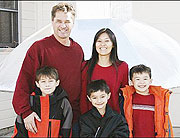The case of the US couple accused of faking the disappearance of their son in a weather balloon is a reminder of the lengths people will go for fame in our celebrity-obsessed culture, says Professor Ellis Cashmore. Celebrity is like a vampire’s kiss - once bitten, the victim develops an uncontrollable desire for blood or, apparently in this case, fame. Victims quickly become victimisers and prey on unsuspecting innocents.


The case of the US couple accused of faking the disappearance of their son in a weather balloon is a reminder of the lengths people will go for fame in our celebrity-obsessed culture, says Professor Ellis Cashmore.
Celebrity is like a vampire’s kiss - once bitten, the victim develops an uncontrollable desire for blood or, apparently in this case, fame.
Victims quickly become victimisers and prey on unsuspecting innocents.
It is not clear whether we can ever call the media innocents, although in the recent case of the Heenes, they were certainly turned into gullible victims.
The case raises the question of how far people will go to stay on the celebrity radar.
Baby Jessica case
Colorado residents Richard and Mayumi Heene are accused of faking the disappearance of their six-year-old son in a saucer-shaped mini-blimp.
If true, had they been thinking of the Baby Jessica case, in which an 18-month-old toddler was trapped in an abandoned well in Texas for 59 hours in 1987?
The story hijacked all others and dominated the American newspapers and airwaves for days.
There is even a movie based on the story, which ended happily with Jessica’s rescue.
The Heenes’ story had a different denouement, though one entirely in keeping with the celebrity-obsessed 21st Century.
Having twice featured on ABC network’s Wife Swap, in which couples from different backgrounds exchange partners for a short period of time, Mr and Mrs Heene were something of reality TV veterans.
And if their plan was to bring the media like rats following the Pied Piper, they succeeded.
The story was colossal. The drama of the runaway weather balloon kept the nation spellbound for hours. Afterwards, the family gave numerous TV interviews.
TV shams
But now the couple face charges, and if convicted, they could enjoy another term as celebrities of sorts - prison sentences of up to six years.
The case is a reminder that TV is full of shams.
It is not uncommon in the US for people to make up lurid stories just to secure airtime.
Some people argue that is not such a bad thing. Celebrity culture has a democratic element - it is not just those with talent who get their moment of fame.
Potentially, anyone who can engage fans - by which I mean all of us - can be a celebrity.
But what of the culpability of the media? In the era of the internet, the media is locked in a race to process and distribute news.
Both print and traditional broadcast media are beginning to look like laggards, chasing the suppler and instantly reflexive online news.
Now, all kinds of media are inclined to skip the period of reflection that might, in the Heene case, have prompted suspicion.
Zealous media
And in terms of reality TV itself, it is not above ratings-boosting pranks.
Two years ago, the Dutch TV station launched The Big Donor Show (De Grote Donorshow), which was ostensibly a tasteless but ultimately worthy spectacle in which a woman decided to which one of three terminally ill patients she would donate her kidney.
The woman was later revealed as an actor, while the patients were real enough.
The producers argued that they wanted to highlight the chronic shortage of organ donations.
They did; they also drew handsome ratings and publicity from all over.
The entanglements of celebrity culture are such that nobody is entirely to blame - we are all part victim, part perpetrator.
The media is zealous in its enthusiasm for stories and, in many cases, the provenance or even propriety of those stories is of secondary importance.
The makers of Starsuckers, a documentary scheduled for release in the UK soon, fabricated a series of stories about celebs, fed them to newspapers and saw their handiwork appear in print.
Calculating?
While it is easy to dismiss the Heenes’ apparent behaviour as the manic operation of people so possessed of celebrity culture that they would do literally anything to grab headlines, this is also misleading.
The Heenes could be seen as ingenious and, by some accounts, calculating aspirants - authorities reckon they planned the balloon scam as publicity for another reality show about bizarre scientific experiments - and they are not as untypical as we might comfortably assume them to be.
We cannot explore their exact motives if indeed they did perpetrate this stunt, but we could safely bet they were trying to earn themselves an extension on the lease of fame they gained through their earlier TV appearances.
It is possible that they have succeeded too - who knows for how long the Heene name is going to be registered in popular consciousness?
If time is spent behind bars, their fame could be perpetuated.
Despite signs of a decline, the reality TV shows in which the Heenes sought - and found - a limited fame will be around for years to come.
Ratings remain high and there is no denying they consistently interest us in a way no other genre can do.
The format is a perfect complement for a culture that rewards presence and punishes obscurity.
When Andy Warhol made his famous prediction about the universality of abbreviated fame, he couldn’t have known how his prediction was to become a mandate.
We live in an age when it is almost everyone’s bounden duty to pursue fame, or notoriety, by whatever means we can.
Perhaps we have all been caressed by the vampire.
BBC


